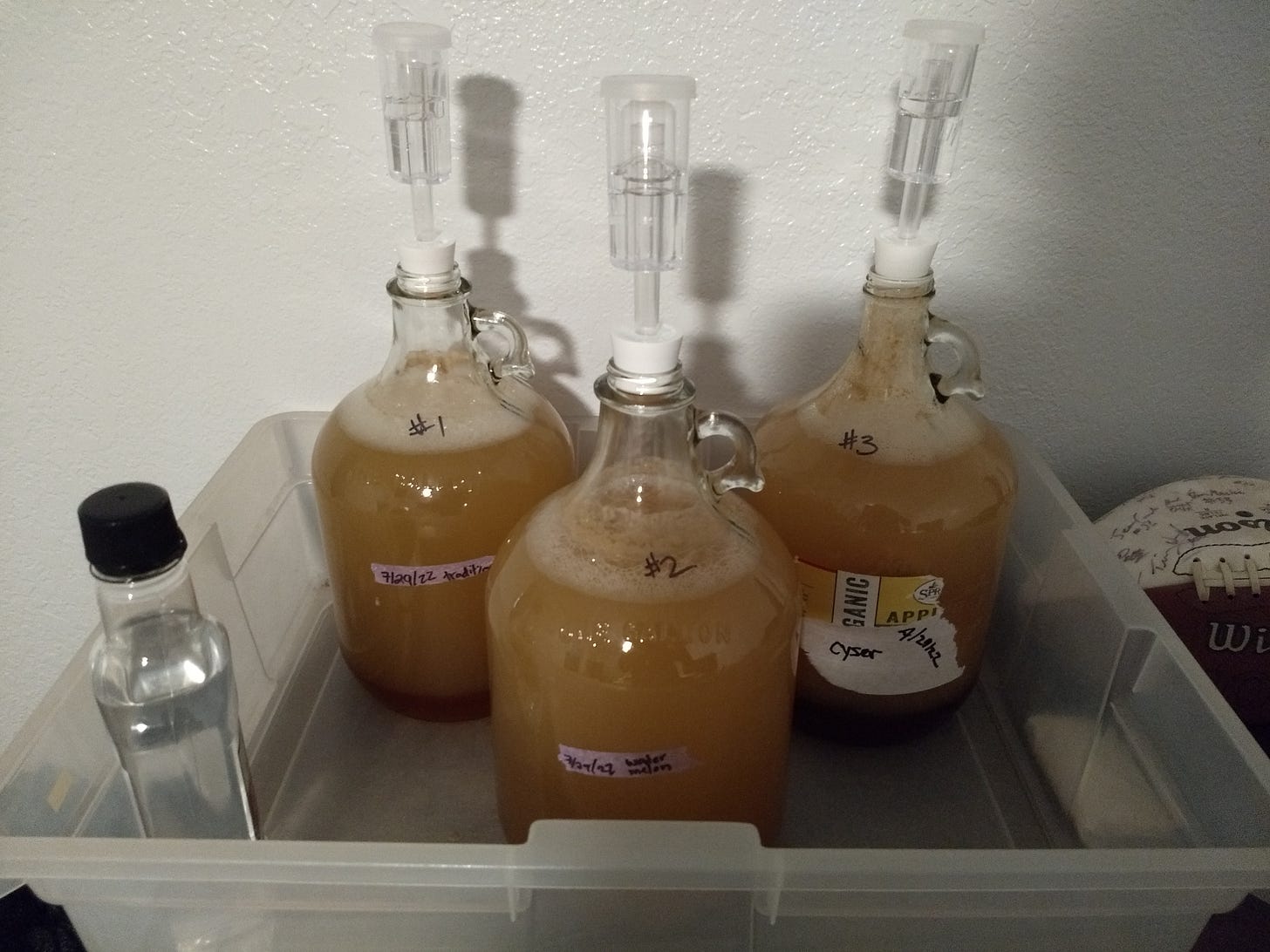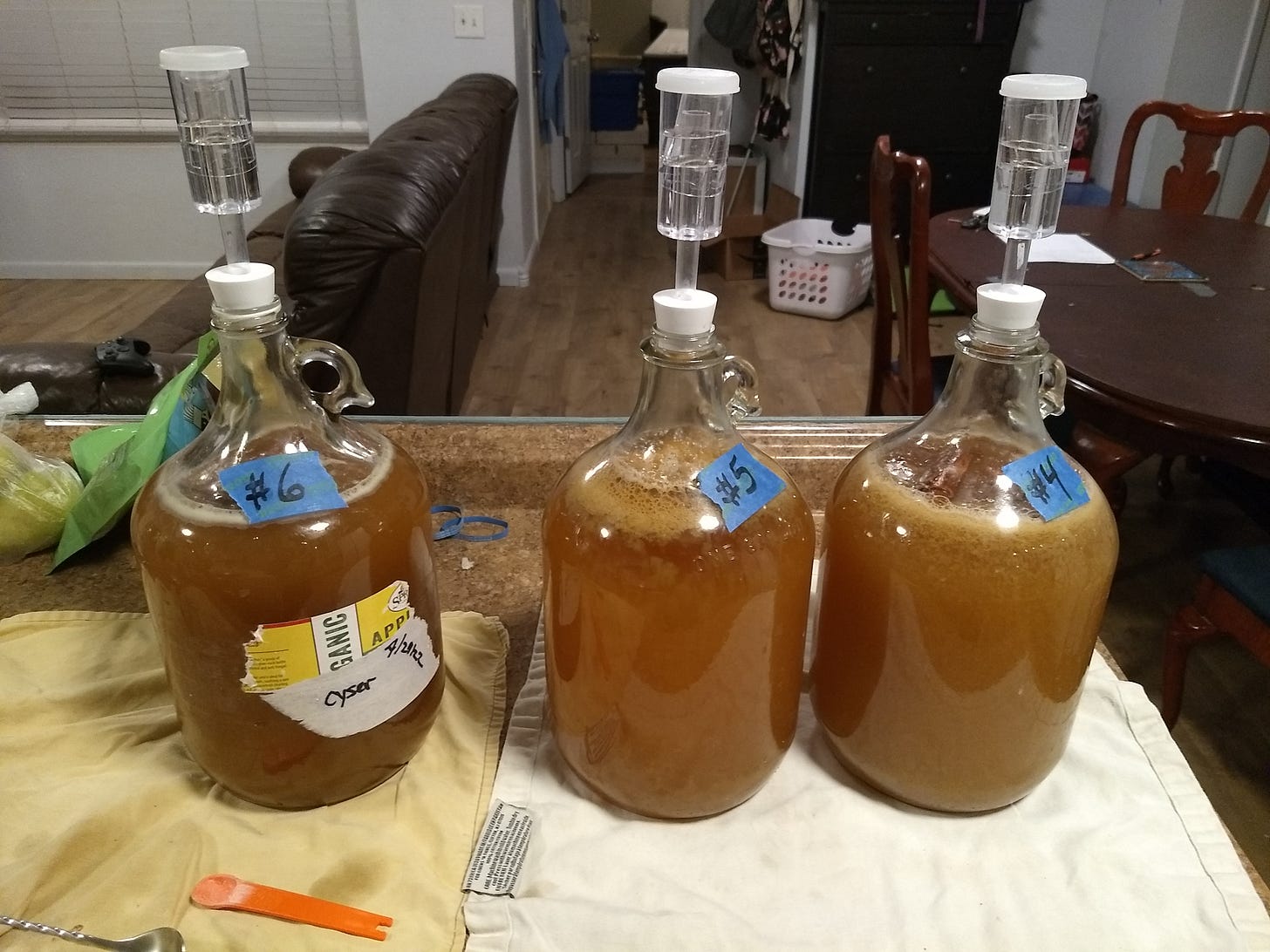Today I want to talk about brewing. One of the things that Mr Greer has always talked about is that having useful skills will get you much further in the Long Descent than anything else. Gold can be stolen, supplies can be taken, you can be driven off land. But skills are things that cannot be taken or stolen, and useful ones means that you will always be in demand and can earn a living. It was also mentioned, that everyone loves the guy that brews alcohol!
As someone who also loves alcohol, in particular the sweet stuff (beer tastes awful to me), brewing mead has always appealed to me. So for this year, I made it my goal to start brewing. I’ve brewed 6 gallons so far, and have found it to be a fun experiment and hobby thus far. I have a lot of ideas on stuff I want to try, but I am trying to stick to the basics so far to get a better understanding of how the various processes work.
I’ve also found that it is pretty economical to brew my own mead. A decent bottle that holds around a pint goes for about $15-20 in my local area. I can make a little less than a gallon (about 7 pints) for around $40. My startup costs for the initial setup were around $150, so I’ve easily saved several hundred dollars doing it myself.

There is a lot to learn, and Reddit (specifically this Reddit) has been very helpful in understanding the basics. Mead is also super easy to brew. You only need honey, water and yeast to make a basic mead, though there is a lot of nuance and options available for those three simple ingredients. Let’s tackle them one at a time.
Honey is the primary ingredient, and gives the yeast all the sugar it needs to ferment. I’ve been mostly using Costco brand honey, but want to play around later with more local varieties. It doesn’t need to be processed or pasteurized, and you can use raw honey as easily as you can the store bought stuff. For a dry mead, you want about 3 lbs of honey per gallon, a semi-sweet needs about 3.5lbs, and 4lbs+ for sweeter meads. Always remember that it is easier to add honey later, than it is to take it out, so erring on the dry side isn’t a bad way to go. You can back sweeten the mead after fermentation is done by adding a few additives to kill the yeast.
Water needs to be free from contaminates, so no tap water. I buy spring water from my local grocery store and it has served me well. The better the ingredients, the better the mead. Typically tap water has so many chemicals added that they can give off flavors or even kill your yeast before it has a chance to really do its job. My in laws own a ranch house in the middle of no where New Mexico, and I really want to try making some meads with their well water at some point.
Lastly, you have the yeast. You can use regular bread yeast if need be, but there are so many brewing specific yeasts out there now that do the job much better that its kind of silly to. My first batch of 3 gallons was made with Lalvin K1-V1116, which I later found out was a wine yeast. It does a good job, but because its a wine yeast, it can need a long time to age (6 months to a year) for any off flavors to melllow out. As someone who isn’t terribly patient, I switched to Kveik Voss yeast for my second batch, which produces a high quality mead in about a month or two. Kveik yeast also has a higher temperature tolerance, which will work nicely for when I start brewing in the summer heat of Arizona (I’ll still be brewing inside, but my wife likes to up the temperature in the house to not have a high power bill). Many yeasts have a temperature tolerance, and Kveik’s is quite high (if you go over this temp, you can kill the yeast or get off flavors).
My first mead experiment was started back in July, and consisted of 2 gallons of traditional dry mead, and 1 gallon of a cyser using the Lalvin yeast. What is a cyser? It is where you use some sort of juice, instead of water. Same rules apply, you want pure juice with no preservatives and the like. My cyser was apple, with a cinnamon stick thrown in (I was going for an apple cinnamon flavor, hopefully ready by Xmas). Of the three, I liked the cyser best.
So for my second experiment, started in October, I did three cysers, but varied them slightly, all with the Kveik yeast. One I didn’t add the cinnamon, one I made identical to my first batch, and the last I used a friend’s raw honey that he had harvested at his father-in-law’s place. Initial readings indicated that the raw honey was sweeter than the store bought stuff. All used the same apple juice, instead of water.
The results so far have been promising. Things I’ll do different next time:
Add less cinnamon. I added a full stick, and the mead tastes almost spicy with the cinnamon, but not quite. Not unpleasant, but a little overpowering.
Try different varieties of honey. The raw worked really well, and I want to try some different local varieties.
Kveik did exactly as it advertised. A good drinkable mead in a month or so. All my meads for the next bit will be Kveik.
If you are interested in brewing yourself, I encourage you to take it up. It is really only a few hours of work, and a whole lot of hurry up and wait. Sanitation is probably the biggest thing that should be taken seriously, so you don’t start growing mold (everything should be washed and sanitized before it touches your mead). I now have a ton of recipes I want to test (including a peanut butter and chocolate mead), and they are going to make great Christmas presents this year! I also had a grand time with my best friend, when he came over, and we taste tested all of the meads during the Thanksgiving weekend!
Everyone loves the guy who makes alcohol, so I’m going to do my best to learn the tools of this trade, so I can be that guy, when the Long Descent begins in earnest. Hopefully I still have a lot more time to perfect this craft.





That's a great write-up, thank you!
About eight years ago, I spent a summer experimenting with making fruit wines with wild yeast, a la Sandor Katz. Results varied (b/c wild yeast...), but I can confirm that it's easy and a *lot* of fun. I had up to fifteen gallon jugs with airlocks bubbling away on my counter...
I might need to get back to fermenting beverages. Thanks again.
Thnaks for this. Making mead in on my list of things to take up.